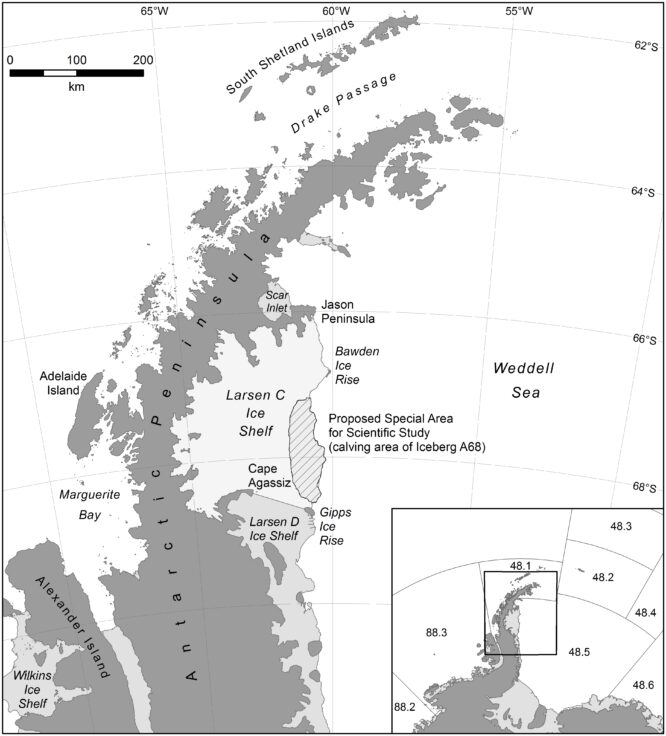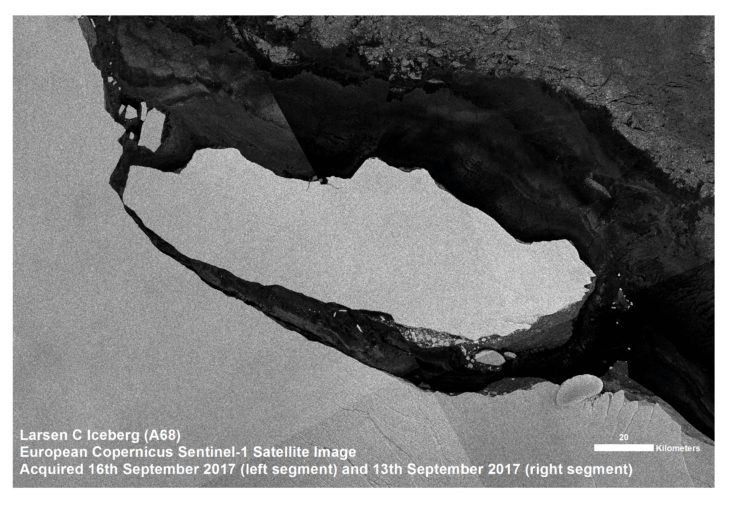Special protection for area exposed by Larsen C iceberg
An international agreement is now in place to give special protection to the area of ocean left exposed when one of the largest icebergs ever recorded broke free from the Larsen C Ice Shelf in July this year. The iceberg – known as A68 – is starting to move north, and it will leave behind a 5,818 km2 area of seabed exposed to open marine conditions. Much of this area may have been ice-covered since the last inter-glacial period around 120,000 years ago, providing a unique opportunity for scientists to study how marine life responds to this dramatic change.
This area is the first to benefit from an international agreement in 2016 by the Commission for the Conservation of Antarctic Marine Living Resources (CCAMLR), to designate Special Areas for Scientific Study in newly-exposed marine areas following the collapse or retreat of ice shelves across the Antarctic Peninsula region. The agreement came following a European Union proposal to CCAMLR, led by British Antarctic Survey (BAS) scientists Dr Susie Grant and Dr Phil Trathan.

The new Special Area for Scientific Study meets the CCAMLR criteria to be automatically designated for an initial period of two years, which is likely to be extended to ten years following further consideration by CCAMLR Members. This will allow for scientific research to be undertaken in the area without any impact from commercial fishing, to address questions relating to how biological communities develop over time, and how new species colonise previously ice-covered areas.
Dr Susie Grant, a marine biogeographer at BAS says:
“The Larsen C iceberg calving has generated a unique and exciting scientific opportunity, and the importance of this area has been further recognised through CCAMLR’s agreement to designate it as a Special Area for Scientific Study. The new designation is a significant addition to CCAMLR’s suite of area-based management tools.”
Dr Phil Trathan, Head of Conservation Biology at BAS says:
“The calving of A68 offers a new and unprecedented opportunity to establish a fundamental scientific programme to address questions focussed on the mobility and colonisation capacity of benthic marine species. Such a programme could address fundamental questions relating to the sustainability of polar continental shelves under climate change, including potentially the processes by which benthic populations migrate, the extent to which benthic organisms act as a biological carbon sink, and the degree to which the distribution of marine benthos can be used to interpret past responses to climate change in various systems. Exploiting this new opportunity, in the absence of fishing, creates an exciting challenge for the international scientific community in this period of unprecedented climate change.”
The Larsen C calving event may simply reflect the natural growth and decay cycle of an ice shelf, and is not necessarily due to changes in environmental conditions. However, studying the biological response to such events will provide an opportunity to improve scientific understanding of possible ecosystem responses to the impacts of climate change in this region and elsewhere.

A team from BAS are now exploring opportunities to access the region to carry out research projects on the benthic environment.
Conservation Measure 24-04 background
CCAMLR Members agreed Conservation Measure 24-04 on “Establishing time-limited Special Areas for Scientific Study in newly exposed marine areas following ice-shelf retreat or collapse in Statistical Subareas 48.1, 48.5 and 88.3” in 2016, following a proposal by the European Union and its Member States, led by UK scientists. The Conservation Measure sets out criteria by which Stage 1 Special Areas are automatically designated for an initial period of 2 years following the notification of all Members of the location and extent of the proposed area. Further information on the characteristics of the Special Area are then considered by the CCAMLR Scientific Committee and its Working Groups, which provides advice to the Commission on the designation of a Stage 2 Special Area for a further 10 year period. Members are encouraged to undertake research in Special Areas for Scientific Study, particularly in order to understand ecosystem processes in relation to climate change. Research fishing activities are only permitted under certain conditions, with the agreement of the Scientific Committee. More about CCAMLR here